Human Physiology by Dr. Manisha Majumdar (De) (best desktop ebook reader .TXT) 📖

- Author: Dr. Manisha Majumdar (De)
Book online «Human Physiology by Dr. Manisha Majumdar (De) (best desktop ebook reader .TXT) 📖». Author Dr. Manisha Majumdar (De)
Before the myosin heads bind to the actin of the thin filaments, they act as ATPase enzymes, splitting ATP into ADP and Pi. This activates the head so they can bind to actin and form a cross-bridge. Once a myosin head binds to actin, it undergoes a conformational (shape) change, pulling the thin filament toward the center of the sarcomeres (Fig. 14.5(b)) in a power stroke. At the end of the power stroke, the myosin head binds to a new molecule of ATP. This allows the cross-bridge cycle (Fig. 14.8), which repeats as long the muscle is stimulated to contract. The cross-bridge cycle in muscle contraction with ADP and Pi attached to the myosin head (Fig. 14.8(a)), the head is in a conformation that can bind to actin and form a cross-bridge (Fig. 14.8(b)). Binding causes the myosin head to assume a more bent conformation, moving the thin filament along with the thick filament and releasing ADP and Pi (Fig. 14.8(c)). Binding of ATP to the head detaches the cross-bridge; cleaved of ATP into ADP and Pi puts the head into its original conformation, allowing the cycle to begin again (Fig. 14.8(d)).
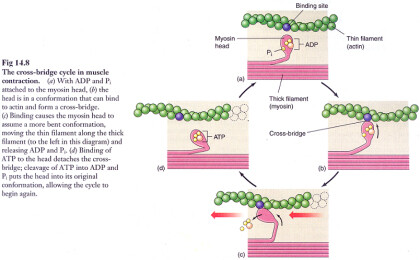
Control of muscle contraction
Role of Ca++ in contraction
When a muscle is relaxed, its myosin heads are “cocked” and ready, through the splitting of ATP, but are unable to bind to actin. This is because the attachment sites for the myosin heads on the actin are physically blocked by another protein, known as tropomyosin, in the thin filaments. Cross-bridges therefore cannot form in the relaxed muscle, and the filaments cannot slide.
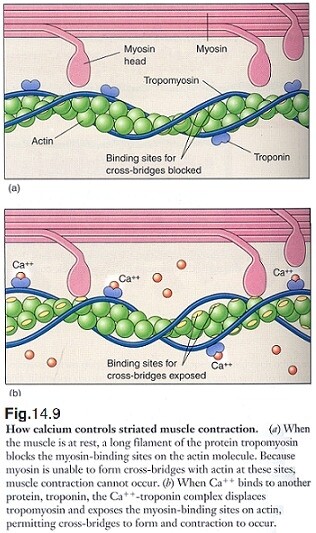
In order to contract a muscle, the tropomyosin
must be moved out of the way so that the
myosin heads can bind to the uncovered actin
attachment sites. This requires the action of
troponin, a regulatory protein complex that
holds tropomyosin and actin together. The
regulatory interactions between troponin and
tropomyosin are controlled by the calcium
ion (Ca++) concentration of the muscle cell
cytoplasm.
When the muscle is at rest, a long filament of
the protein tropomyosin blocks the myosin-binding
sites on the actin molecule. Because myosin is
unable to form cross-bridge with actin at those sites,
muscle contraction cannot occur and at this time
Ca++ concentration of muscle cell cytoplasm is
low (Fig. 14.9(a)). When the Ca++ concentration
is raised, Ca++ binds to troponin. This causes the
troponin-tropomyosin complex to be shifted away
from the attachment sites for the myosin heads on
the actin. Cross-bridges can thus form, undergo
power strokes and produce muscle contraction
(Fig. 14.9(b)).
Where does the Ca++ come from?
Muscle fibers store Ca++ in a modified endoplasmic reticulum called a sarcoplasmic reticulum or SR (Fig. 14.10). When a muscle fiber is stimulated to contract, an electrical impulse travels down into the muscle fiber through invaginations of the cell membrane called transverse tubule (T tubules). This triggers the release of Ca++ from the SR. Ca++ then diffuses into the myofibrils, where it binds to troponin and causes contraction. The contraction of muscle is regulated by nerve activity, and so nerves must influence the distribution of Ca++ in the muscle fiber.
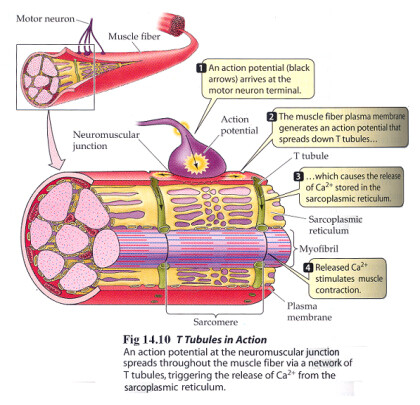
Muscle contractions are initiated by action potentials from motor neurons arriving at the neuromuscular junctions. Motor neurons are generally highly branched and can synapse with up to a hundred muscle fibers each. All the fibers activated by a single motor neuron constitute a motor unit and contract simultaneously in response to the action potentials fired by the motor neurons. The particular motor neurons that stimulate skeletal muscles are called somatic motor neuron (Fig. 14.10). In human, each muscle fiber only has a single synapse with a branch of one axon.
Contraction of muscle by nervous stimulation has following events:
1. Motor neuron secretes acetylcholine (Ach) neurotransmitter which acts on muscle fiber membrane to stimulate muscle fiber to produce its own electrochemical impulses.
2. Impulses spread along membrane of muscle fiber and are carried into muscle fibers through T tubules.
3. T tubules conduct impulses toward SR, which then releases Ca++.
When impulses from the nerve ceases, the nerve stops releasing Ach. This stops the production of impulses in the muscle fiber. When the T tubules no longer produce impulses, Ca++ is pumped back into SR by active transport. Troponin is no longer bound to Ca++, so tropomyosin returns to its inhibitory position, allowing muscle to relax.
The involvement of Ca++ in muscle contraction is called excitation – contraction coupling because it is the release of Ca++ that links the excitation of muscle fiber by the motor neuron to the contraction of the muscle.
Classification of skeletal muscular system
Skeletal muscular system may be classified on the basis of function (Fig. 14.11). Muscle may work independently or in coordination to allow smooth and precise movement. Muscles attached to a joint often work in pairs so that if one muscle contracts the other muscle will relax.
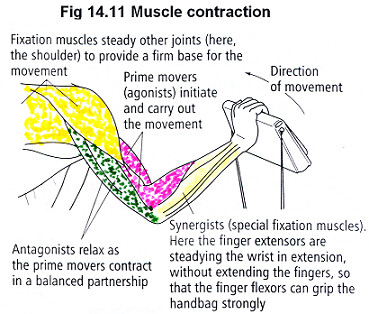
Prime movers: Muscles that have the main responsibility for an action because they move and contract are called prime movers.
Antagonists muscle: Muscles that limit and counteract the movements are called antagonists. In a pair of working muscles the roles may be reversed.
Synergists: Groups of muscles that work together to produce a movement are called synergists. Synergists work to assist the prime mover and stabilize joints. Synergists may also prevent a movement at a joint, and the group of muscles is then called fixator.
The biceps are the prime movers to the flex the elbow, and they are the antagonist when the elbow is lowered.
Information on the tension and state of the muscles is transmitted to the brain via receptors in the muscle called muscle spindles. The muscle spindle is a collection of modified muscle fibers that are enclosed in connective tissue. The connective tissue connects the receptors to surrounding muscle fibers. As the muscle fibers move, the spindle becomes elongated and information about muscle activity is transmitted to the brain. Similar receptors are also present in the tendons.
Properties of muscles
There are seven properties that are required for muscle tissue functions:
Excitability: it reacts to electrical signals from the nervous system. Contractibility: muscle tissue is able to become shorter and thicker (to contract). Extensibility: muscle tissue is able to stretch(extend) without causing damage. Elasticity: muscle tissue is able to go back to its original shape when relaxed. Conductibility: once a part of the muscle fiber is stimulated by a stimulus of adequate strength, it is conducted within no time to all its other parts. Threshold or liminal: All the muscles contract only when they receive the stimulation of certain strength. The lowest limit of stimulus capable to bring contraction in muscles is called threshold or liminal stimulus. Refractory period: After stimulation, there is a brief period during which the muscle does not remain in a excitable state, this period is refractory period or the period of relaxation of muscle.
Red and white muscle
On the basis of concentration of hemoglobin present in skeletal muscle, it may be divided into red and white muscle.
Red muscle: This muscle contains very high concentration hemoglobin (which is called myoglobin).
White muscle: This muscle contains very low amount of myoglobin. Myoglobin can store oxygen which is utilized by the mitochondria for the synthesis of ATP as when required.
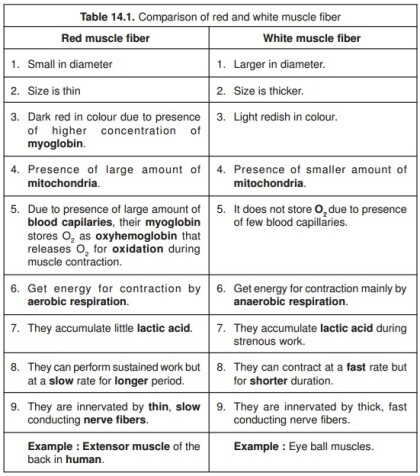
Types of skeletal muscle contraction
Muscles contract to produce tension that will maintain the bone of the muscle or move the skeleton. The tension of the muscle must be able to produce a force that will be sufficient to produce the movement required. Picking up a pencil or a bag full of books will demand different tensions to overcome the weight of the two objects.
Muscle fiber twitches
An isolated skeletal muscle can be studied by stimulating it artificially with electric shocks. If a muscle is stimulated with a single electric shock, it will quickly contract and relax in a response called a twitch.
Summation
Increasing the stimulus voltage increases the strength of the twitch up to maximum. If a second electric shock is delivered immediately after the first, it will produce a second twitch that may partially “ride piggy back” on the first. This cumulative response is called summation.
Treppe or staircase phenomenon
If the stimulus is repeated, the muscle continues spasmodic contractions that increase in intensity called treppe or staircase phenomenon. Warm-up exercises before physical activity are aimed at producing treppe to prepare the muscle to produce maximum effort.
Tetanus
If the muscle is not allowed to relax due to repeated stimulation, the twitch contraction will produce a powerful continuous contraction called tetanus. The powerful contraction reduces the oxygen supply to the muscle fibers and this causes pain.
Tetanus may occur following physical activity and it is called cramp. Cramp may also occur with lower-level muscle activity after sitting awkwardly and this is then called a spasm. If tetanus occurs there will be a period of intense pain until the muscle receives oxygen. Massage will help to speed up the return of the oxygen supply and relieves the pain.
Muscle fatigue
Muscle fatigue refers to the use-dependent decrease in the ability of a muscle to generate force. The reasons for fatigue are not entirely understood. In most cases, however muscle fatigue is correlated with the production of lactic acid by the exercising muscles. Lactic acid is produced by the anaerobic respiration of glucose, and glucose is obtained from muscle glycogen and from the blood. Lactate production and muscle fatigue are therefore also related to the depletion of muscle glycogen.
Fatigue muscle needs extra oxygen to dispose of excess lactic acid. After a strenuous exercise, faster breathing should be continued for some time to supply extra oxygen for oxidizing excess lactic acid. This results in the disappearance of fatigue.
Rigor mortis
In death, the cell can no longer produce ATP, and therefore the cross-bridges cannot be broken – this causes the muscle stiffness of death called rigor mortis. The cross-bridge is formed by binding myosin head with actin head after splitting ATP into ADP and Pi. A living cell, however, always has enough ATP to allow the myosin heads to detach from actin. How, then, is the cross-bridge cycle arrested so that muscle can relax? The regulation of muscle contraction and relaxation requires addition factors also. The muscle goes into a state of “death rigor”, and becomes stiff. Rigor mortis disappears some fifteen to twenty-five hours after death as proteins are degraded.
Isotonic and isometric contraction
Tension of the muscle is required to move an object, when the object is moving the muscle shortens as the skeletal joints moves. No further tension is required and this contraction is called isotonic.
When lifting a heavy object the tension of the muscle must be increased before the object can be moved. The muscle length stays the same although contraction is occurring. This contraction is called isometric. When lifting objects, isotonic and isometric contractions are needed for movements.
Summary
The movement is a complex series of coordinating functions of the skeletal, muscle and nervous system. The movement of skeletal muscle occurs at joints or articulations, where one bone meets another. Three main classes of joints are immovable, slightly movable and freely movable of synovial joints. In immovable joints there is no space between articulating joints and the synovial cavity. In slightly movable or cartilagenous joints, there is no synovial cavity and bones are held together with cartilage. In synovial joint the articulating ends of the bones are located within a synovial cavity filled with lubricating fluid. Synovial joints are classified into six subtypes according to the range of movements they allow. These are planner joints, hinge joints, pivot joints, condyloid joints, saddle joints, ball and socket joint. Knee joint is the largest joint in the body and it requires stabilizing by ligaments and tendons. Capsular ligament, synovial membrane, articular cartilage, cruciate ligament, menisci, patella tendon, patella, prepatella bursa and bursa reduce friction movement of knee joint. Most skeletal muscle lies just below the skin and there are approximately 600 named muscles in the body. It is made up of numerous muscle fibers and enclosed in a layer of connective tissue. Sarcolemma is the covering membrane of muscle fiber and sarcoplasm is the cytoplasm of muscle fiber. Thick and thin filaments overlap in pattern and form, which is a functional unit of muscle. The units are called sarcomeres. Sarcomeres are separated from each other by a
 The desire to acquire knowledge about the surrounding world and human society is quite natural and understandable for a person. Life is so developed that an uneducated person will never occupy a high position in any field. Humanity in its mass, and each person individually, develops objectively, regardless of certain life circumstances and obstacles, but with different intensity. The speed of development depends on the quality of training.
The desire to acquire knowledge about the surrounding world and human society is quite natural and understandable for a person. Life is so developed that an uneducated person will never occupy a high position in any field. Humanity in its mass, and each person individually, develops objectively, regardless of certain life circumstances and obstacles, but with different intensity. The speed of development depends on the quality of training.


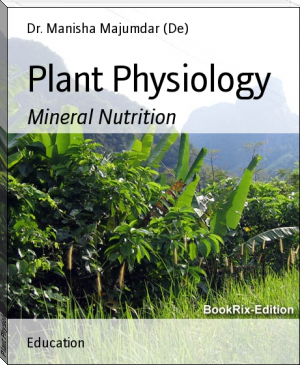

Comments (0)